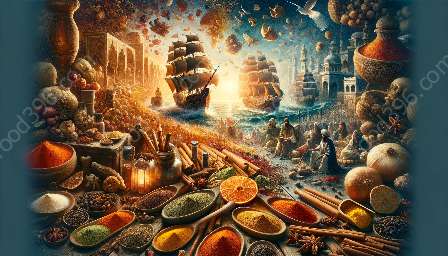Spices have played a pivotal role in fostering cultural exchange throughout history, shaping the food culture and trade of diverse societies. From ancient trade routes to modern culinary practices, the story of spices is an enriching tale of exploration, innovation, and connection.
History of Spices and Their Trade
The history of spices and their trade spans millennia, serving as a testament to the enduring desire for exploration and connection among different cultures. The spice trade holds a significant place in the annals of human history, as it has influenced the rise and fall of empires, led to geographical discoveries, and fostered cultural diffusion.
Ancient Roots
The origins of spice trade can be traced back to ancient civilizations such as Mesopotamia, Egypt, and the Indus Valley, where spices were highly valued for their culinary, medicinal, and preservative properties. The demand for spices led to the establishment of trade routes that connected the Eastern and Western worlds, giving rise to a vibrant exchange of goods, ideas, and traditions.
The Silk Road
The fabled Silk Road, which linked the civilizations of the East and West, was a conduit for the exchange of not only silk but also spices, herbs, and other commodities. This extensive network of trade routes facilitated the intermingling of cultures, religions, and knowledge, marking a significant period of cultural exchange through spices.
Age of Exploration
During the Age of Exploration, European powers embarked on voyages to discover new trade routes to the fabled lands of spices in Asia. These expeditions, notably led by explorers such as Vasco da Gama and Christopher Columbus, reshaped global trade and led to the blending of culinary traditions from different continents.
Food Culture and History
The influence of spices on food culture and history is profound, as they have not only enriched culinary practices but also served as a symbolic representation of cultural identity and heritage.
Culinary Traditions
Spices have been integral to the development of diverse culinary traditions across the globe. From the aromatic blend of spices in Indian curries to the use of exotic flavors in Moroccan cuisine, each culture has infused its unique identity into the art of spice use, creating a tapestry of flavors that reflects their history and values.
Symbolism and Rituals
In many cultures, spices hold symbolic significance and are utilized in traditional rituals and ceremonies. Whether it's the use of saffron in Persian celebrations or the incorporation of cinnamon in Christmas treats, spices serve as a tangible link to cultural heritage and reinforce communal bonds through shared culinary experiences.
Global Fusion
As societies continue to evolve and interact, the fusion of culinary practices has become increasingly prominent. This amalgamation of diverse flavors, influenced by the exchange of spices and trade, has led to the emergence of modern cuisines that celebrate the diversity and interconnectedness of global food culture.
Conclusion
The journey of spices through trade and cultural exchange is a testament to the human pursuit of connection and understanding. From the spice markets of ancient civilizations to the bustling kitchens of modern metropolises, spices have transcended geographical boundaries to weave a rich tapestry of flavors, traditions, and histories.

